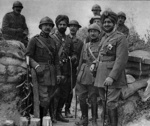Template:AOW225: Difference between revisions
Hari singh (talk | contribs) No edit summary |
Hari singh (talk | contribs) No edit summary |
||
| (2 intermediate revisions by 2 users not shown) | |||
| Line 2: | Line 2: | ||
[[Image:Maharaja patiala.jpg|thumb|150px|left|Maharaja of Patiala at the frontline (April 1915)]] | [[Image:Maharaja patiala.jpg|thumb|150px|left|Maharaja of Patiala at the frontline (April 1915)]] | ||
As soon as the war broke out in early August 1914, | As soon as the war broke out in early August [[1914]], the British and the French quickly mobilized their respective empires. Soldiers and labourers from all over the world soon found themselves on the Western Front. | ||
More than 30 different nationalities were engaged in the Ypres Salient. There was a British [[India]]n infantry division composed of three brigades with four battalions that quickly grew to five battalions after the battle of Neuve-Chapelle in April 1915. | |||
Undoubtedly the British forces were composed of soldiers of the world’s greatest ever empire in 1914. Firstly, there were the Dominions; Canada, Australia, New Zealand and South Africa in addition to the crown colonies of Newfoundland and, of course, our main subject today - the [[Sikh]]s from [[India|British India]]. | |||
But let’s get back to | It is now quite obvious that even though they were united in a common cause, a uniform sense of nation was, at the time and even up to the partition of India, blatantly absent. | ||
The then troops of the British Indian army or the British Indian Labour Corps came from, what is today, the countries of India, Pakistan, Bangladesh, Burma and Nepal. | |||
Even some smaller constituent parts of the British Empire sent their sons to Flanders’ fields, Egypt (Egyptian Labour Corps), BWI (the Caribbean and mainly Jamaica, Trinidad & Tobago and Barbados) and Bermuda, the Fiji Islands (Fijian Labour Corps). Then again, the British army counted white Rhodesians amongst its ranks.<!--- | |||
But let’s get back to the main topic of our talk today; the [[Sikh]]s in the British Indian army and their presence in the Ypres Salient. This means that I will hardly mention Neuve-Chapelle, the main British Indian sector on the Western Front. Though only 25 miles south of Ypres, Neuve-Chapelle is not part of the Ypres Salient. In fact, the British Indian Army Corps was only deployed twice in the Ypres Salient, both times at very crucial moments; at the end of October 1914 during the 1st Battle of Ypres, and at the end of April 1915, during the 2nd Battle.---> {{aowf|Sikh sacrifice in Belgium}} | |||
Latest revision as of 19:45, 25 April 2012
As soon as the war broke out in early August 1914, the British and the French quickly mobilized their respective empires. Soldiers and labourers from all over the world soon found themselves on the Western Front.
More than 30 different nationalities were engaged in the Ypres Salient. There was a British Indian infantry division composed of three brigades with four battalions that quickly grew to five battalions after the battle of Neuve-Chapelle in April 1915.
Undoubtedly the British forces were composed of soldiers of the world’s greatest ever empire in 1914. Firstly, there were the Dominions; Canada, Australia, New Zealand and South Africa in addition to the crown colonies of Newfoundland and, of course, our main subject today - the Sikhs from British India.
It is now quite obvious that even though they were united in a common cause, a uniform sense of nation was, at the time and even up to the partition of India, blatantly absent.
The then troops of the British Indian army or the British Indian Labour Corps came from, what is today, the countries of India, Pakistan, Bangladesh, Burma and Nepal.
Even some smaller constituent parts of the British Empire sent their sons to Flanders’ fields, Egypt (Egyptian Labour Corps), BWI (the Caribbean and mainly Jamaica, Trinidad & Tobago and Barbados) and Bermuda, the Fiji Islands (Fijian Labour Corps). Then again, the British army counted white Rhodesians amongst its ranks. .....More

